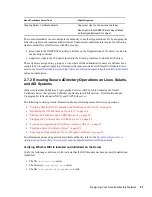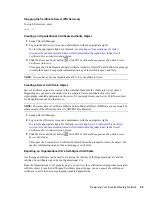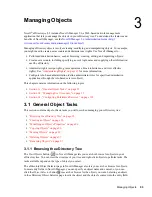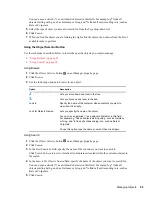
80
Novell eDirectory 8.8 Administration Guide
n
ov
do
cx (e
n)
22
Ju
n
e 20
09
For Windows, look at the DIB Set at
\novell\nds\dibfiles
.
For Linux, Solaris, or AIX, look at the DIB Set in the directory you specified during
installation.
Deciding Which Containers to Create
In general, create containers for objects that have access needs in common with other eDirectory
objects. This lets you service many users with one trustee assignment or login script. You can create
containers specifically to make container login scripts more effective, or you can place two
departments in one container to make login script maintenance more feasible.
Keep users close to the resources they need to limit traffic over the network. For example, people
who work in the same department generally work near each other. They usually need access to the
same file system and they print to the same printers.
Exceptions to general workgroup boundaries are not hard to manage. If two workgroups use a
common printer, for instance, you can create an Alias object to the printer in one of the workgroups.
You can create Group objects to manage some User objects within a workgroup or User objects
across multiple workgroups. You can create Profile objects for subsets of users with unique login
script requirements.
2.3 Guidelines for Partitioning Your Tree
When you partition eDirectory, you allow parts of the database to exist on several servers. With this
capability, you can optimize network use by distributing the eDirectory data processing and storage
load over multiple servers on the network. By default, a single partition is created. For more
information on partitions, refer to
Section 1.5, “Partitions,” on page 51
. For information on creating
partitions, refer to
Chapter 5, “Managing Partitions and Replicas,” on page 131
.
The following are guidelines for most networks. However, depending on the specific configuration,
hardware, and traffic throughput of the network, you might need to adjust some guidelines to fit
your needs.
2.3.1 Determining Partitions for the Upper Layers of the Tree
Just as you design your tree with a pyramid design, you will also partition with a pyramid design.
Your partition structure will have few partitions at the top of the tree and more partitions as you
move toward the bottom. Such a design creates fewer subordinate references than an eDirectory tree
structure that has more partitions at the top than at the bottom.
This pyramid design can be achieved if you always create the partitions relatively close to the leaf
objects, particularly the users. (An exception is the partition created at the root of the tree during
installation.)
When designing the partitions for the upper layers, keep the following in mind:
Partition the top of the tree based on the WAN infrastructure. Place fewer partitions at the top
of the tree with more at the bottom.
You can create containers for each site separated by WAN links (placing each Server object in
its local container), then create a partition for each site.
In a network with WAN links, partitions should not span multiple locations.
Summary of Contents for EDIRECTORY 8.8 SP5
Page 4: ...4 Novell eDirectory 8 8 Administration Guide novdocx en 22 June 2009...
Page 72: ...72 Novell eDirectory 8 8 Administration Guide novdocx en 22 June 2009...
Page 118: ...118 Novell eDirectory 8 8 Administration Guide novdocx en 22 June 2009...
Page 130: ...130 Novell eDirectory 8 8 Administration Guide novdocx en 22 June 2009...
Page 188: ...188 Novell eDirectory 8 8 Administration Guide novdocx en 22 June 2009...
Page 222: ...222 Novell eDirectory 8 8 Administration Guide novdocx en 22 June 2009...
Page 240: ...240 Novell eDirectory 8 8 Administration Guide novdocx en 22 June 2009...
Page 264: ...264 Novell eDirectory 8 8 Administration Guide novdocx en 22 June 2009...
Page 290: ...290 Novell eDirectory 8 8 Administration Guide novdocx en 22 June 2009...
Page 322: ...322 Novell eDirectory 8 8 Administration Guide novdocx en 22 June 2009...
Page 540: ...540 Novell eDirectory 8 8 Administration Guide novdocx en 22 June 2009...
Page 548: ...548 Novell eDirectory 8 8 Administration Guide novdocx en 22 June 2009...
Page 616: ...616 Novell eDirectory 8 8 Administration Guide novdocx en 22 June 2009...
















































